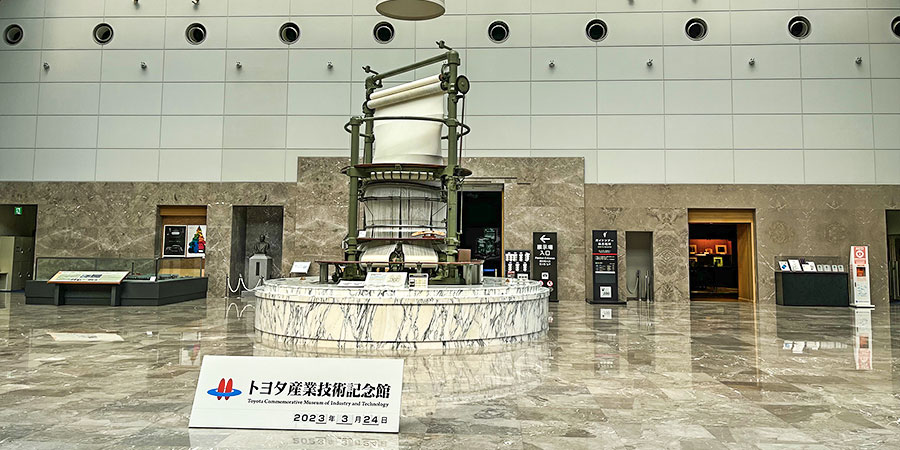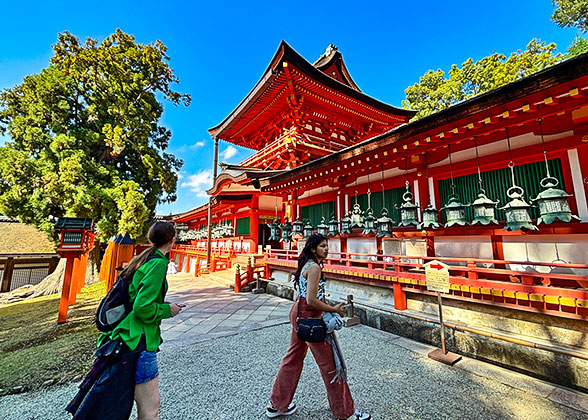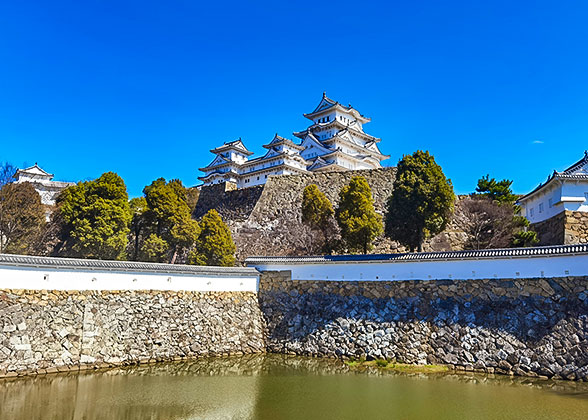- Nagoya Castle
- Atsuta Jingu Shrine
- Osu Kannon
- Toyota Commemorative Museum
- SCMAGLEV and Railway Park
Toyota Commemorative Museum of Industry and Technology
Toyota Commemorative Museum of Industry and Technology is a corporate museum operated by the Toyota Group in Nagoya, Japan. It was built on the former site of Toyota Automatic Weaving Mechanism. The museum mainly introduces Toyota Group’s successful story starting from Automatic Weaving Mechanism to a world-famous automobile manufacturer and the development history of Japan's mechanized textile and automotive industries. The exhibitions are mainly Toyota’s best products from textile machines to various cars. In 2007, Toyota Commemorative Museum of Industry and Technology was officially designated as a “modern industrial heritage” in Japan. You can also find museum shops, restaurants, cafes and library here.

|
What’s Inside?
Covering an area of approximately 27,000 square meters (32,291 square yards), Toyota Commemorative Museum of Industry and Technology mainly consists of a hall, a textile machinery museum, an automobile museum, a technology park, and a Toyota Group museum.The hall includes a memorial room, a large tour navigation screen, and a circular loom invented by old Toyota. The Toyota Group Museum mainly introduces the history of the Toyota Group by video, images, written records and other materials. The technology park provides teenagers with hands-on opportunities, which is actually the implementation of the concept of modern science and technology museums. Through interactive exhibits, various mechanical principles and structures are introduced. The Textile Machinery Pavilion and Automobile Pavilion are where you should spend more time exploring.
Textile Machinery Pavilion
The Textile Machinery Pavilion mainly showcases various textile tools and machines, from primitive textile tools, the earliest power machinery to the latest textile technology. Many machines can be operated and demonstrated on-site to weave various types of fabrics. The main demonstrations are as follows:

|
2. The fundamental three parts of the weaving technology and old tools like the backstrap loom and a ground loom.
3. 12 types of fibers like silk, wool, nylon and polyester.
4. 57 traditional cotton textiles of the world, including Japan.
5. The planting areas and production volumes of cotton flowers.
6. Spinning machines invented during the age of the Industrial Revolution in the mid-18th century by England including Spinning Jenny, Water-frame, and Spinning Mule, which all are replicas. The spinning process is demonstrated through video.
7. One important exhibition is the Garabo throstle spinning machine, the first independently invented textile machine by Japan in 1873. A roving frame, a ring spinning frame and 7 other pieces of textile machinery are also presented.
8. A fully automated spinning system developed by Toyota, high-speed carding machine, high-speed drawing frame, high-speed roving frame, and high-speed spinning frame.
9. The development process of loom technology through a human-operated loom, a power-operated loom, an automatic loom, and a computer-controlled loom. Typical shuttle looms displayed here include Toyoda Power Loom, Non-stop Shuttle Change Automatic Loom (Type G Automatic Loom) that can make one worker operate 30-50 looms at a time, The Assembly Line of the Type G Automatic Loom, The Sakamoto Automatic Cop-Change Loom, Type G3 Toyoda Automatic Loom, Karl Zwangs swivel loom from Germany, and Ruti bilateral four-shuttle loom from Switzerland.
10. New material products produced by textile machinery from clothing that is warm in winter and cool in summer to advanced materials that resist odors, dry quickly, repel water, and having unique textures.
11. Raw materials used for various industrial products, such as a substitute for metal parts, or as a component for aerospace needs, some of which are introduced here such as sports and outdoor products, and automotive parts.
12. A brief introduction to Sakichi Toyoda, the founder of Toyota Group.
|
|
|
Automobile Pavilion
The automobile museum allows you to see the manufacturing machinery of the automobile factory up close. You can also visit the actual operation of the machines and the cars from previous generations. And children can also assemble a model of Toyota by themselves, which can be taken away for free.Must-see Exhibits:
Toyota Automobiles:

|
1. A replica of Toyoda Type AA Passenger Car in 1936
2. The first-generation Celcior in 1989
3. The Crown in 1955.
4. The RT40 Corona in 1964, and the new Corolla in 1966.
5. A three-way catalytic converter, oxygen sensors and an EFI (electronic fuel injection system) and the Tercel/Corsa in 1978.
6. The LS400 in 1989.
7. The Prius and the Mirai in 2012 and 2014 respectively.

|
Other exhibits:
1. A wooden 1:1 scale model and a 1:5 scale clay model of a truck in the 1950s.

|
2. A transfer machine (1969), a LeBlond crankshaft milling machine from the U.S. (1964), and a Toyota articulated drilling machine (1996).
3. Fifteen various machine tools used at the business starting period, including a small-sized lathe, a drill press, and imported machine tools.
4. The 600-ton press machine of 11.5 m in height and 235 t in weight, the largest exhibition in size in this museum
Demo Hour for Machines and Performance
|
Location |
Machines and Performance |
Demo & Performance Length |
Timetable |
|
Entrance Lobby |
Circular Loom |
5 minutes |
9:55, 11:25, 13:25, 14:55 |
|
Court |
Steam Engine |
5 minutes |
11:00, 14:30, 15:30 |
|
Creative Workshop |
Live TECHNO Show |
15 minutes |
11:30, 14:00, 16:00(Only Sat, Sun and Holidays) |
|
Demonstration Area of Metal Working Technologies |
Casting |
10 minutes |
11:30, 14:20 |
|
Forging |
10 minutes |
9:40-16:30 every 10 minutes |
|
|
Cutting |
10 minutes |
10:50, 14:50 |
|
|
South Lobby |
Partner Robot Violin Performance |
10 minutes |
11:10, 13:20, 14:40, 15:40, 16:40 |
Travel Note
1. English introduction by museum guides are provided at 2pm and 3:15pm, with a total duration of 45 minutes. It is available for free.2. You may also rent an audio recording guide tour device, which will provide a detailed introduction to the museum’s craftsmanship, history, and more.
How to Get There
By subway
You can walk 1 minute to get to Meitetsu Nagoya Station from Nagoya Station and take the Inuyama Line and get off at Sakō Station. Then you can get to Toyota Commemorative Museum of Industry and Technology after walking about 5 minutes. That takes about 10 minutes and costs 180 yen.By bus
You can take the Me~guru Nagoya Sightseeing Bus at Nagoya Station Bus Terminal Platform No.11 and get off at the Toyota Commemorative Museum of Industry and Technology stop.Opening Time
Opening time: 9:30-17:00, stop entry at 16:30.Closed on Monday, or Tuesday if Monday is a national holiday; and at the end of the year or beginning of the year.
Ticket
1,000 yenSenior (aged 65 or over): 600 yen with passport
Children under 7: free of charge.
You can get a 20% discount on the entrance ticket fare if you hold the TOYOTA TS CUBIC CARD (TS3) or use Nagoya Sightseeing Route Bus Me~guru One-Day Pass, Donichi Eco Kippu (Weekend Eco Ticket), Me~guru One-Day Pass (Nagoya Sightseeing Route Bus).
Combo Ticket with Other Museums
Toyota Commemorative Museum of Industry and Technology and Noritake Garden’s Craft Center: 1,200 yen for adultsToyota Commemorative Museum of Industry and Technology and Toyota Automobile Museum: 1,800 yen for adults; 980 yen for seniors aged 65 or over




